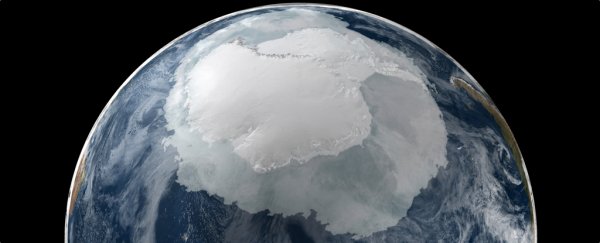Mud cores drilled in Mississippi hold long-hidden clues about the origins of gigantic Antarctic ice sheets around 34 million years ago, new research shows.
Earth was in the midst of a major transition at the time, shifting from the balmy Eocene Epoch to the cooler Oligocene. The planet had no permanent ice during the Eocene, but by the early Oligocene, it already featured ice sheets 25 percent larger than those we know today.
As those ice sheets grew during the Eocene-Oligocene transition, sea levels also fell by roughly 40 meters (131 feet), exposing swaths of previously submerged land in the wake of receding coastlines.
That dramatic drop in sea levels unleashed a major carbon transfer from coastal sediments into the atmosphere, according to the research team's analysis of ancient mud from the same time period collected near Jackson, Mississippi.
"We've unearthed information from the Mississippi mud to answer a key question about how Antarctic ice massively expanded to continental scale," says senior author Tom Dunkley Jones, a micropaleontologist and paleoceanographer at the University of Birmingham in the UK.
These Antarctic ice sheets, the study's authors note, originally formed due to the long-term burial of carbon in sediments, sequestering it away from the atmosphere, where it famously has a heat-trapping effect.
That drop in atmospheric carbon also enabled Earth's broader transition to the cooler modern climate of the past 34 million years, they add, creating chillier conditions that helped massive ice sheets form in Antarctica, which in turn led to the global decrease in sea levels.
This all happened too quickly for many species to adapt, resulting in a widespread mass extinction as previous research has shown. This turbulent period is also known by the French nickname Grande Coupure, for "great cut."
"The Eocene-Oligocene transition is probably the planet's biggest climate cooling event and has had a major impact on the Earth's history," Dunkley Jones says.
Amid this overall cooling trend, however, falling sea levels caused by Antarctica's glaciation also led to another, opposing trend, Dunkley Jones and his colleagues report.
The retreating ocean laid bare large regions of coastal sediments, leaving them vulnerable to extreme erosion. These soft, soggy sediments contained large volumes of plant matter and other organic debris, which were no longer protected by seawater.

As these mangrove-like habitats dried out, their legacy of organic material was exposed to oxygen and became a feast for microbes, which released its sequestered carbon into the atmosphere as carbon dioxide.
This surge of CO2 was enough to cause a "transient negative feedback to climate cooling," the researchers write, briefly undercutting the planet's transition to an "icehouse" climate.
"As sea levels fell over this transition, we can observe how a temporary brake on atmospheric cooling took place with the release of large amounts of carbon dioxide sequestered in coastal regions around the basin of the Mississippi River," Dunkley Jones says.
The transfer of carbon from these coastal sediments may not have stopped the planet's progression into the cooler Oligocene climate, the team notes, but it does reveal an important detail about how this complex system works.
"Our paper gives us a valuable new clue about how Earth's climate can undergo dramatic shifts and how this is often strongly linked to the biosphere and carbon cycle," says Kirsty Edgar, a micropaleontologist and paleoceanographer at the University of Birmingham.
The study examined marine clays from about 137 meters deep, comparing data from them with clues about the Eocene-Oligocene transition from elsewhere, especially the Pacific Ocean.
This revealed long-term changes in the accumulation of sediments, the researchers explain, clarifying the timing of sea-level declines that coincided with formation of the ice sheets.
"Understanding these past events gives us a clearer picture of the beauty and complexity of the Earth's climate and ecology," says Edgar.
The study was published in Nature Communications.
